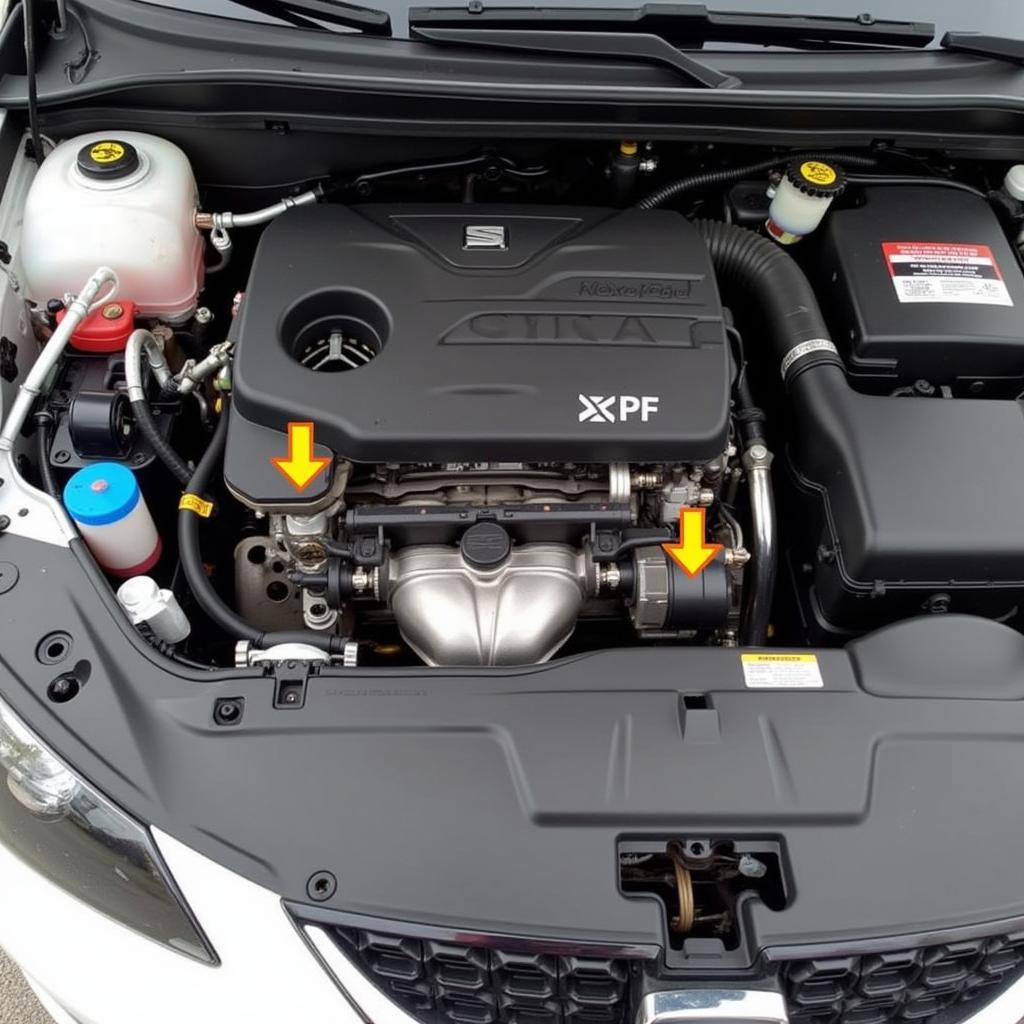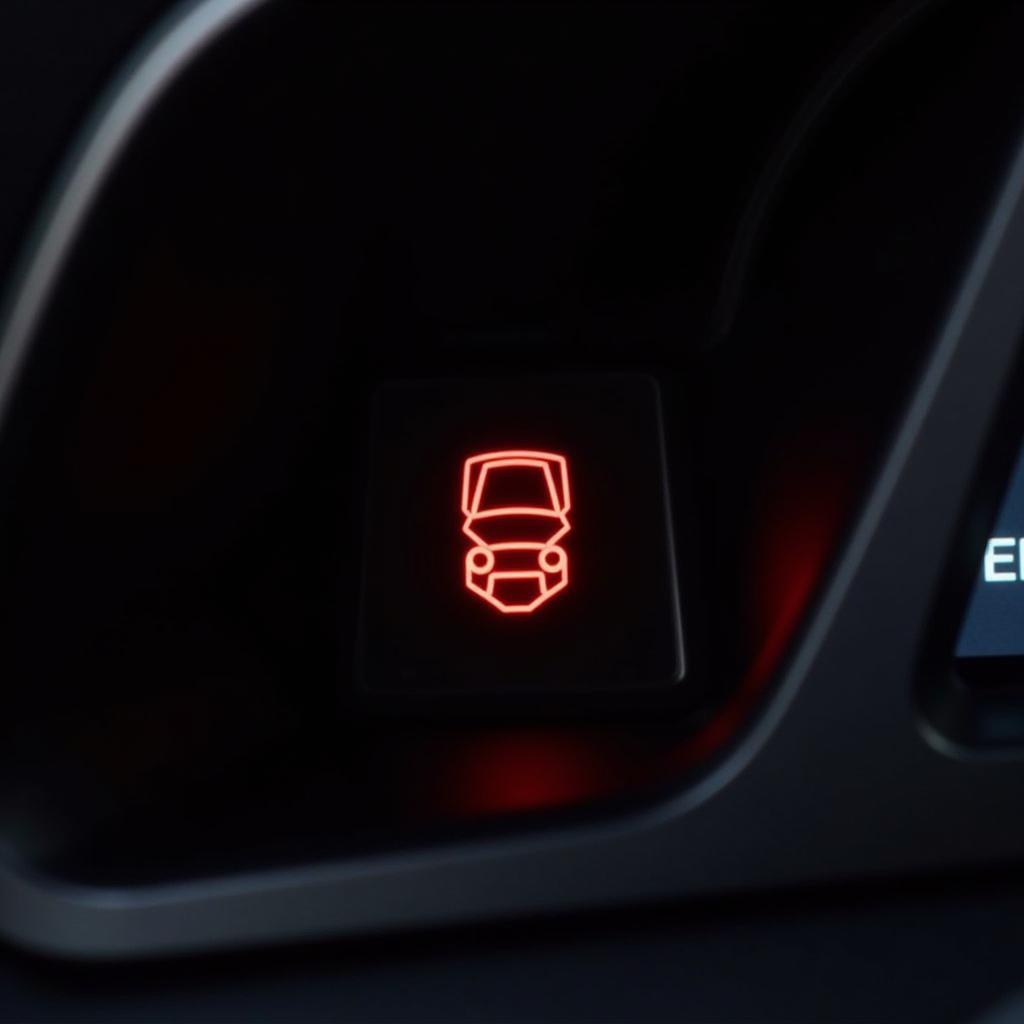The dreaded DPF warning light on your Seat Leon’s dashboard can be a source of anxiety for many drivers. It signals there’s an issue with your Diesel Particulate Filter (DPF), a crucial component in modern diesel vehicles. This comprehensive guide delves into the intricacies of the Seat Leon DPF warning, empowering you to understand its causes and navigate potential solutions.
What is a DPF and How Does it Work?
Before we dive into the specifics of the Seat Leon DPF warning, let’s understand the role of this vital component. Modern diesel engines are engineered to be fuel-efficient and environmentally friendly. The DPF plays a critical role in achieving this by capturing and storing soot particles from the exhaust gases. Think of it as a sophisticated filter that prevents harmful particulates from being released into the atmosphere.
The DPF, typically located in the exhaust system, uses a honeycomb structure coated with precious metals like platinum and palladium. These act as catalysts, burning off the accumulated soot at high temperatures in a process called “regeneration.”
Why is My Seat Leon DPF Light On?
Now, let’s address the elephant in the room—why your Seat Leon is displaying a DPF warning light. Several factors can trigger this warning, ranging from driving habits to underlying mechanical issues:
- Frequent Short Journeys: If your daily commute consists mainly of short trips where the engine doesn’t reach optimal operating temperature, the DPF might not regenerate properly. This can lead to soot buildup and trigger the warning light.
- Faulty Sensors: Your Seat Leon uses various sensors to monitor the DPF’s performance. A malfunctioning sensor, like the differential pressure sensor, can provide inaccurate readings, causing the warning light to illuminate.
- Blocked DPF: Excessive soot buildup can eventually clog the DPF, hindering its ability to regenerate. This is a common issue, especially for vehicles primarily used for short city drives.
- Faulty EGR Valve: The Exhaust Gas Recirculation (EGR) valve redirects a portion of exhaust gases back into the combustion chamber to reduce emissions. A faulty EGR valve can disrupt this process, leading to increased soot production and DPF problems.
- DPF Regeneration Issues: While the DPF is designed to regenerate automatically, sometimes this process can be interrupted or fail altogether. This could be due to a faulty DPF pressure sensor, a problem with the engine control unit (ECU), or other factors.
 Seat Leon DPF Location
Seat Leon DPF Location
Common Symptoms of DPF Problems in a Seat Leon
Aside from the illuminated DPF warning light, you might notice other symptoms that indicate a problem with your Seat Leon’s DPF system:
- Reduced Engine Performance: A clogged DPF can restrict exhaust flow, leading to reduced engine power, sluggish acceleration, and a noticeable drop in fuel economy.
- Black Smoke from Exhaust: While diesel engines typically emit some black smoke during acceleration, excessive black smoke can indicate a DPF issue, particularly if it’s accompanied by a strong smell of diesel fuel.
- Engine Going into Limp Mode: In severe cases, your Seat Leon’s ECU might put the engine into “limp mode” to prevent further damage. This limits the engine’s power output, forcing you to drive at a reduced speed.
How to Fix the Seat Leon DPF Warning Light
Now that we’ve covered the potential causes, let’s explore the possible solutions for addressing the DPF warning light on your Seat Leon:
- Force a DPF Regeneration: If the issue is due to frequent short trips and a partially blocked DPF, a forced regeneration might be the solution. This involves driving at a sustained speed on a highway or open road to increase exhaust temperature and initiate the regeneration process. However, it’s crucial to consult your owner’s manual or a trusted mechanic before attempting this.
- Check and Clean Sensors: If a faulty sensor is the culprit, it needs to be replaced. This typically involves diagnosing the specific sensor causing the issue and replacing it with a new one.
- Clean or Replace the DPF: A severely blocked DPF might require professional cleaning or replacement. While cleaning can be a more cost-effective option, a heavily damaged DPF might necessitate a complete replacement.
- Inspect and Repair the EGR Valve: If the EGR valve is malfunctioning, it needs to be inspected and potentially cleaned or replaced.
 Using a Diagnostic Tool on a Seat Leon
Using a Diagnostic Tool on a Seat Leon
Can I Continue Driving with the DPF Warning Light On?
While it might be tempting to ignore the DPF warning light, especially if your Seat Leon seems to be running fine, it’s not recommended. Continued driving with a DPF problem can lead to severe and costly engine damage. If the warning light persists, it’s crucial to address the issue promptly.
Preventive Measures to Avoid DPF Issues
Prevention is always better than cure. Here are some preventive measures to keep your Seat Leon’s DPF in optimal condition:
- Avoid Frequent Short Journeys: Whenever possible, try to incorporate longer drives into your routine to allow the DPF to regenerate naturally.
- Use High-Quality Diesel Fuel and Additives: Opting for premium diesel fuels and DPF-specific additives can help keep the DPF clean and improve its regeneration efficiency.
- Schedule Regular DPF Checks: Incorporate periodic DPF checks into your vehicle’s maintenance schedule to identify potential issues early on.
Seeking Professional Help: When to Consult a Mechanic
While this guide provides a comprehensive overview of the Seat Leon DPF warning, remember that diagnosing and repairing DPF issues often requires specialized knowledge and tools. If you’re unsure about any aspect of your DPF system or encounter persistent warning lights, it’s always best to seek professional help from a qualified mechanic specializing in Seat vehicles.
Conclusion
The DPF warning light on your Seat Leon shouldn’t be ignored. By understanding the function of the DPF, recognizing the potential causes of DPF issues, and taking appropriate preventive measures, you can ensure the optimal performance and longevity of your vehicle. Remember, a proactive approach to DPF maintenance can save you from costly repairs and keep your Seat Leon running smoothly for miles to come.
seat leon particulate filter warning light
FAQs
What does the Seat Leon DPF warning light look like?
The DPF warning light on a Seat Leon typically resembles a filter with dots inside, and it might be yellow or orange.
Can I remove the DPF from my Seat Leon?
Tampering with or removing the DPF is illegal in many countries and can lead to fines and vehicle failure during emissions testing.
How much does it cost to fix a DPF problem in a Seat Leon?
The cost of DPF repair can vary widely depending on the severity of the issue, ranging from a few hundred dollars for sensor replacement to over a thousand dollars for DPF cleaning or replacement.
How often should I expect to replace the DPF on my Seat Leon?
With proper maintenance, a DPF can last the lifetime of the vehicle. However, factors like driving habits and fuel quality can influence its lifespan.
Can I use fuel additives to clean the DPF in my Seat Leon?
Yes, using DPF-specific fuel additives can help improve DPF regeneration and reduce soot buildup. However, it’s essential to choose reputable brands and consult your owner’s manual for recommendations.
seat leon fr exhaust warning light
What is the difference between active and passive DPF regeneration?
Passive regeneration occurs automatically during highway driving, while active regeneration is initiated by the ECU under specific conditions and might require you to drive at a certain speed for a set duration.
seat leon spanner warning light
How can I prevent future DPF problems in my Seat Leon?
Avoiding frequent short trips, using high-quality diesel fuel and additives, and scheduling regular DPF checks are effective preventive measures.


